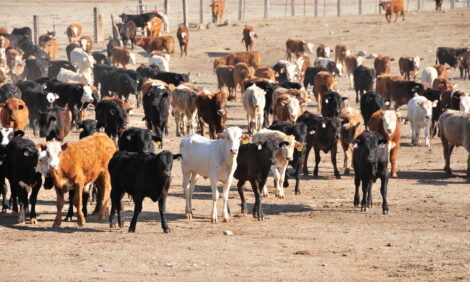



Hay Choices for Cattle Producers
US - Cattle producers and equine enthusiasts in the Southern Great Plains rely heavily on introduced warm-season grasses for their winter hay needs. Primarily, these grasses are either bermudagrass or old world bluestem varieties.All varieties of old world bluestem and many varieties of bermudagrass are established from seed, but certain varieties of bermudagrass can only be established via sprigging because these varieties are hybrids and do not produce viable seed. Little information is readily available that allows producers to make economic comparisons between seeded and sprigged varieties of introduced warm-season grasses nor is there information that allows them to determine the best economical rates of nitrogen (N) fertilizer to apply to these grasses.
The purpose of this article is to provide producers in the Southern Great Plains with information about the economics of nine varieties of introduced warm-season grasses and the most economical nitrogen fertilizer rate for those grasses.
Data is summarized from a three-year (2008, 2009 and 2010), completely randomized-block-designed field study conducted at the Noble Foundation's Pasture Demonstration Farm near Ardmore, Okla. This study was designed to evaluate forage yield and quality for nine varieties of introduced perennial grasses (six seeded and three sprigged varieties). The seeded varieties of bermudagrass included Cheyenne, Common, a mix of Common and Giant, and Wrangler.
The old world bluestem varieties included B Dahl and Plains, and the sprigged varieties of bermudagrass included Coastal, Midland 99 and Tifton 85. Yield and quality measures, crude protein (CP) and total digestible nutrients (TDN), were collected from the study for each of the nine varieties fertilized with five rates of nitrogen fertilizer (0, 50, 100, 200 and 300 pounds per acre). Extended details about the agronomic study can be found in a Noble Foundation Fact Sheet.
Enterprise budgeting techniques were used to compute values for revenue, production costs and net return to land, owner's labor, management, and farm overhead for two alternative hay enterprises, including a large round bale (1,200 pounds) preferred by cattle producers and a small square bale (55 pounds) preferred by equine enthusiasts. Hay prices as reported by the Oklahoma Department of Agriculture were used. Hay with CP and TDN above 10 percent and 60 percent, respectively, was given a premium price while all other hay was assigned the average price. Local market prices for 2011 for nitrogen fertilizer, grass seed, sprigs and pesticides, and published Oklahoma custom rates for field operations (disking, field cultivation, sprigging, broadcasting, and fertilizer and pesticide application) were used (oces.okstate.edu/kay/ag/CustomRates%202011-2012.pdf).
Three-year average values for the economical level of nitrogen, yield, net return and corresponding economic rankings by variety for large round and small square bale enterprises are reported in Table 1. For the large round bale enterprise, the most economical variety (rank = 1) was Tifton 85, one of the three sprigged varieties of bermudagrass, which generated 5.1 tons per acre (8.5 large round bales per acre) and $160 net return per acre. The next best grass variety (rank = 2) for production of large round bales was the old world bluestem variety B Dahl, which generated 4.3 tons per acre (7.2 bales per acre) and $107 per acre in net return. In the case of large round bales, the remaining seven varieties were substantially less profitable than both Tifton 85 and B Dahl.
For the small square bale enterprise, Tifton 85 was the most profitable variety (rank = 1). However, it is important to emphasize that many equine enthusiasts do not prefer Tifton 85 due to its appearance. With this in mind, the next best variety (rank = 2) was Coastal, which is also a sprigged variety of bermudagrass. Coastal generated 3.8 tons per acre (138 small square bales) with the economical rate of 100 pounds of N per acre providing for $184 per acre of net return. The Midland 99 sprigged variety of bermudagrass (rank = 3) generated a slightly lower net return of $167 per acre. The old world bluestem variety B Dahl also provided a respectable net return of $137 per acre (rank = 4). However, B Dahl is generally not preferred by equine enthusiasts.
In summary, our results showed that sprigged varieties of bermudagrass, especially Tifton 85 and Coastal, were economically superior to the seeded varieties. Net returns for all varieties were sensitive to the price of large round and small square bales, but the individual economic rankings were not. For lower hay prices, net returns for all varieties were lower, but the economic rankings remained unchanged and vice versa for higher hay prices. Similar results were found for both higher and lower nitrogen prices.
TheCattleSite News Desk


